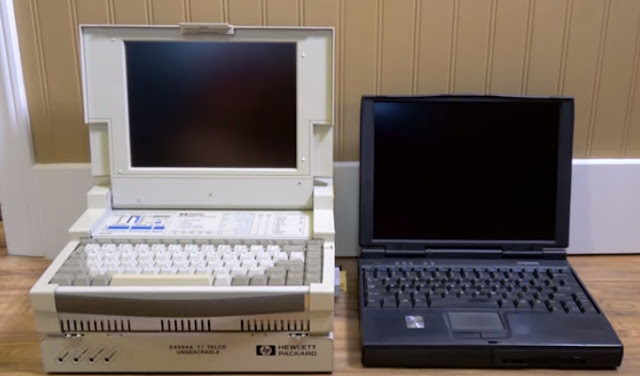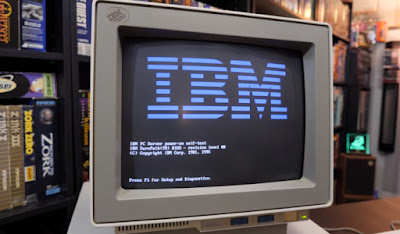It’s time to look at another computer that I find fascinating and been wanting to talk about, and now’s the time to do so, because arbitrary reasons. This is the Hewlett-Packard J2301B Wide Area Network Internet Adviser. With an E4594A-T1 telco under cradle. What even is this?
Well, It is the most complicated and bulletproof laptop I own. Although calling it a laptop is a bit misleading; It weighs 20 pounds! (9 kilograms) You do not want this thing on your lap, and there’s no practical reason to own this nowadays;
it’s just enjoyable overkill. I just like having silly machines like this and as soon as I saw it on eBay some years back, I had to have one, and... well, this is the one I picked out!
My machine was manufactured by HP in 1998, but the division responsible for it is now known as Key sight, which itself is a spin-off of a spin-off of HP known as Agilent. And you’ll see a lot of internet advisor machines under the Agilent brand. They did really well for themselves too!

In fact, in November 18th, 1999, their IPO was the largest in Silicon Valley history up to then, at 2.1 billion dollars!
So yeah, they did really well with the equipment like this. And considering the cost, I mean I guess that makes sense. It was $20 000 for this in 1998, down to $13 500 for the later C model in 1999. I have no clue what the T1 under cradle underneath costs. This module is just probably several thousand more dollars at least. Well, what does all of this even do, though, is the question!
Well it is a 486-based computer so it runs Windows 95 and games and DOS, and, you know whatever. It’s just a 90s computer at heart. But it’s got a bunch of specialty hardware and equipment that the idea is that it non-intrusively monitors and decodes WAN and LAN protocols by capturing packets. Basically, the internet advisor advises technicians about the internet!
And its specialized using various under cradles, like the T1 module in this case. Take that off, swap it out for other things. Whatever you needed. This was leased out to various telcos and other companies that needed this kind of stuff.
It was never really made for consumers, but they ended up flooding the consumer market anyway after they were decommissioned sometime in the mid- to late-2000s.
The more predictable consumer-level hardware is the 486 DX4 100 MHz CPU, 16 MB of RAM, 1.3 GB hard drive, SVGA graphics, 1.44 MB 3½″ floppy drive and a PCMCIA slot. Yeah, nothing terribly groundbreaking, especially for the late 90s. It’s just a million and a half other ports and DIP switches and all these things...I don’t know what they do, but they look great. Makes me feel like I’m doing something important. Speaking of being relatively clueless as to what some of this crap does, I won’t pretend to know what all this software does.
There’s a lot of it that was preloaded on here for doing all kinds of diagnostic doohickeys, but I don’t know. This is completely out of my realm of expertise, so maybe someone that actually worked on these things back in the day could enlighten me in the comments because I am curious beyond what I can already find on Google and Wikipedia.
It also has a 10½″ TFT LCD, which is pretty small for how big the rest of the machine is. And the keyboard itself has a rather cramped layout too, with a really mushy set of keys. I’m not very much a fan of this. And oddly enough, since this was designed for Windows 95 and 98, there’s no Windows keys on here at all. I guess they just didn’t need them, but I don’t know. Kind of strange. Another neat feature is that it’s so big, they just stuff the whole power supply inside the computer. It uses a standard three-pronged PC power cable. “I don’t see any touchpads or anything”, but yes there is!
It has an amazing mouse, look at this!
You press this little mouse square here, and it pops right out!

Appropriately enough, this is called the HP pop-out mouse, which was also used in their HP Omni book series of computers. It’s a really cool industrial design just all over, and that’s really why I got this. I just like the way it looks:
There’s a lot of metal everywhere, nothing gets in the way, there is no plastic crap hiding things. In fact, when I got this, I replaced the backlight bulb for the LCD because it was really dark. But, oddly enough, that didn’t seem to help. It’s still a really dark screen, so I end up using an external monitor whenever I want to do anything on here beyond a few minutes.
And there’s stuff that I do want to do on here! I mean, it’s got a 100 MHz DX4. Sadly, it does not have any sound card. I could install one via PCMCIA, although I don’t have one of those. It does have a PC speaker that is amusingly
shrill, sharp-sounding. Listen to this!
Anyhow, overall the HP Internet Advisor is just stupid fun to me. Its heavy, its loud and it’s just delightful. There’s all sorts of little features that I just dig, like when you turn it on,
It lights up like a Christmas tree!
Look at all these lights!
They just keep flashing and animating all over the place!
This stuff doesn’t really do anything in my case, I’m not using all of the telco components, but here it is anyway, and I appreciate it. Playing games on a machine that was $20 000 at one point is completely ridiculous, and that’s why I like it.
I mean, it’s like taking a steamroller to a drive through!
Its huge, and expensive, and way more for the task at hand, but that’s what makes these kinds of things so awesomely enjoyable.
And I hope you at least found this somewhat as enjoyable to watch
as I’ve enjoyed messing with it!
And if you enjoyed this quick look at a thing of computers,
And as always, thank you very much for watching.
IBM 8516 Touchscreen CRT Monitor

Comments
Post a Comment